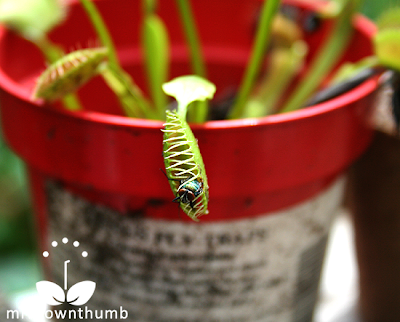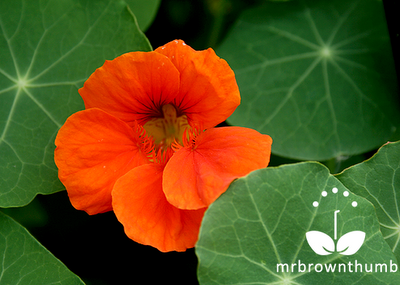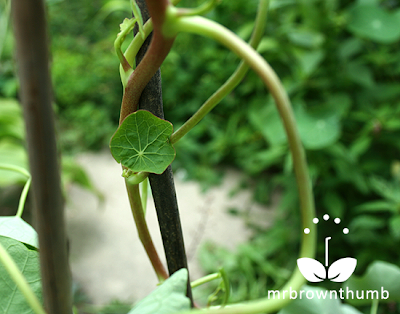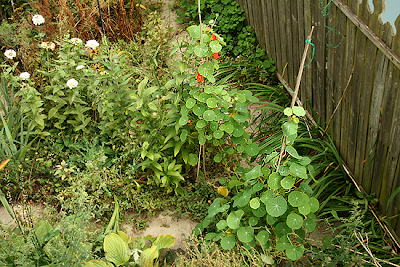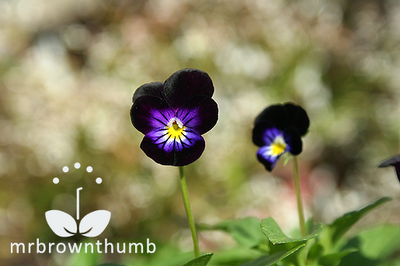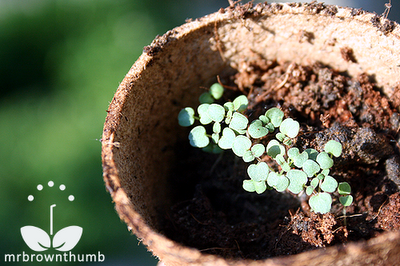 |
| Lithops fulviceps "Living Stones." "Flowering Stones." |
Search
12.12.10
How to Repot Lithops "Living Stones"
Lithops are mimicry plants commonly called “living stones,” “living rocks,” and “flowering stones.” These weird succulent plants have evolved to resemble pebbles and rocks in their native habitat of southern Africa to avoid being eaten by animals during times of drought. I recently gave one to my nephew, in part inspired by the book Toad Cottages and Shooting Stars, in the hopes that the plant would spark something in him. Before he could receive the plant I was called and informed that it had fallen out of the pot. Being the houseplant doctor in the family I was tasked with repotting the Lithops plant.
5.12.10
Potting Jade Cuttings
This summer I had the opportunity to visit California for a few days. The last time I was there I was a pre-teen who didn’t care about plants. Returning as a gardening addict, sometimes adult, I was completely floored by a lot of things about California, most of them plant related. In particular I couldn't believe the succulents growing in my aunt’s garden. I’m accustomed to seeing Jade plants of various sizes, but I’ve never seen them in person growing as shrubs before. Knowing succulent plants were easy to propagate from cuttings, I brought back a few cuttings with me from one of the shrubs. Unfortunately, I forgot about them once I arrived back home until just the other day when I found the Jade cuttings in a bag.
27.11.10
How to Store Seeds You Saved From Your Garden
Once you've learned how to save seeds from your garden for next year the next step is storing the seeds after you have made sure they are properly dried. Seed storage of your ornamental and edible plants is easy and once you’ve tried a few methods you’ll find one that works best for you and you’ll also discover that some rules can be bent if not broken altogether.Storing saved seeds gives you an opportunity to recycle those jars and containers you clean out and put aside in case you need them one day. I’ll provide some ideas and guidelines for how I store seeds saved from my garden, but you should feel free to experiment with your own stash of saved seeds.
22.11.10
Four O' Clock Flower Tubers
The Four o’clock success in the garden continued this month when I was digging around the garden and discovered the Four o’clock tubers. I went from harvesting four o’clock seeds that I couldn’t germinate, to having a successful germination rate this year and even four o'clock blooms. In a previous post a garden commented that propagating four o’clocks vegetatively was easier than growing them from seeds and the reason I searched for these tubers in the garden.
17.11.10
How to Collect Hyacinth Bean Vine Seeds
If you’re looking for a quick-growing annual vine that will cover a fence or garden trellis you would be hard-pressed to find a better one than the hyacinth bean vine. Purple hyacinth bean vine leaves are attractive and heart-shaped, pink-purple blooms and produce leathery purple seed pods that provide interest long after the blooms have faded. A member of the Fabaceae family this ornamental vine is a relative of beans and peas and makes an attractive addition to vegetable and ornamental gardens. Easy to start from seed, hyacinth bean vine seeds are easy to collect at the end of the growing season.
12.11.10
Growing Potatoes In Buckets Or Trash Cans
When I think of potatoes I don’t often think about growing them on a porch in a city and I certainly don’t think about them growing in buckets or trash cans. The last couple of years there has been a lot written about growing spuds in trash cans and buckets in urban gardens and part of the reason I decided to grow them for the first time above ground. Growing potatoes in buckets or trash cans is so easy that I’d recommend it for any small-space urban gardeners and for container gardening enthusiasts. While not as glamorous as growing tomatoes in small spaces growing your own potatoes is just as rewarding when you sit down and take a bite of spuds you grew yourself.


8.11.10
How to Collect Canna Seeds
The popularity of the tropical plants commonly called cannas (sometimes called canna lily) is no surprise to anyone who has ever grown these plants. From gnarled perennial rhizomes (not canna bulbs) emerge large leaves similar to bananas and gingers (sometimes colorful or stripped) and beautiful blooms in a variety of colors. When we gardeners in northern climates plant cannas in our gardens we usually plant the rhizome in the spring and summer and then lift it in the winter and store indoors. Propagating cannas is easy because all you need is a piece of the rhizome, but you can also propagate cannas from seeds if you know how to collect canna seeds.
29.10.10
Toad Cottages & Shooting Stars
Do grandparents need a book to help them create memories with their grandchildren? That’s the first thing I thought of when I received my review copy of the book, Toad Cottages & Shooting Stars
 by Sharon Lovejoy. The book is written by a grandmother for grandmothers. So why is a 30 something guy reviewing the book? Simple, this book is awesome! There's lots of useful tips and ideas in this book for creating budding naturalists.
by Sharon Lovejoy. The book is written by a grandmother for grandmothers. So why is a 30 something guy reviewing the book? Simple, this book is awesome! There's lots of useful tips and ideas in this book for creating budding naturalists.
26.10.10
How To Collect Columbine Flower Seeds
If you’re looking for perennials for your garden that are east to grow you can’t go wrong with columbine plants. Columbine flower colors come in a wide assortment due to hybridization and there is probably one suited to your garden’s color scheme. It is unfortunate, in my estimation at least, that columbine flowers are forever linked to the tragic events of 1999, I actually prefer to use the genus name Aquilegia because of this. The columbine flower’s meaning doesn’t make it any more appealing to me either. Columbine flowers are suppose to be symbols of ingratitude, faithlessness and representative of deceived lovers. If after reading all this you still want to grow columbine’s in your garden-you’re in luck. Once you know how to collect columbine flower seeds you’ll have more columbines that you know what to do with.
21.10.10
How to Save Seeds
A recent visitor to this garden blog asked me what the benefit of saving seeds from the garden for next year. The answer can be a rather long one involving issues like income, consumerism, and even politics when we get into the area of genetically modified organisms and saving heirloom seeds. The biggest benefit for me of saving seeds for next year is that I create a backup of my garden should plants die or get stolen. While saving seeds from vegetables, flowers and fruits you're creating your own personal seed bank. Below are some seed saving tips and techniques I rely on to save seeds from plants in my garden. Hopefully they'll be of use to new gardeners who come across this.
19.10.10
How To Collect Basil Seeds
Of all the edible plants people can grow in their gardens, or in containers, basil has to be the easiest of them all. No herb garden is complete without at least one basil plant growing. My only problem with growing basil is the price of basil seedlings and seeds of the nicer basil cultivars available. Growing basil from seeds is very easy and the most affordable way to grow many basil plants. Once you've grown a basil plant saving seeds from your basil plant is very easy, you just need to learn where to look on the plant so you know how to collect basil seeds.
17.10.10
Pocket Seed Banks
While not all gardeners may enjoy or participate in the fall ritual of harvesting and saving seeds, it is probably my favorite gardening activity. After actually starting plants from seeds for my garden, seed saving is the gardening activity that makes me feel most like a gardener. I'm amazed that a plant can grow from something that is sometimes the size of the period at the end of a sentence. When harvesting and saving seeds in my garden, visiting other gardens or just walking around my city; I often find a seed or seed pod I collect by placing in my pocket. Seed savers or seed snatchers, if you will, know to carry plastic and paper bags this time of year for the dangling seeds and seed pods that beckon to be collected and saved. Here's how I create pocket seed banks recycling tin mint containers.
12.10.10
Ornamental Sweet Potato Vine Propagation
Ornamental sweet potato vine, Ipomoea batatas, are regular fixtures in many gardens and public plantings all over. Their drought tolerant nature make them ideal low-maintenance plants, perfect for container gardens, hanging baskets and mass planting in beds. Ornamental sweet potato vines are grown mostly for their foliage, but I really enjoy their flowers. Especially the flowers of sweet potato cultivars like 'Blackie.'
10.10.10
'Chocolate Rose Silk' Japanese Morning Glory
My ‘Chocolate Rose Silk’ Japanese morning glory came from a seed trade years ago. This spring I finally got around to sowing the morning glory seeds and growing out a couple of plants. My morning glory’s blooms most closely resemble the Ipomoea nil ‘Chocolate Rose Silk’ available for sale at a couple of different seed websites and that’s what I’ve chosen to identify my plant as.
8.10.10
'Cardinal Climber' Vine Ipomoea sloteri
Cardinal Climber , Ipomoea sloteri, is a hybrid of Ipomoea quamoclit, 'Cypress Vine,' and Ipomoea coccinea. A synonym for Ipomoea sloteri is Ipomoea x multifida. Cardinal Climber vine is a member of the morning glory family. The deeply cut leaves, deep red blooms festoon vines that can grow up to 15 feet in length.
4.10.10
'Creamsicle' Nasturtium, Mounding
When I planted my 'Spitfire' nasturtiums one plant produced a bloom that was quite different from the orange-red colored flowers of 'Spitfire.' The first bloom was very yellow which made me think it was 'Peach Melba,' but subsequent blooms have looked much different than that first one. The yellow color has turned out to be more pink and and the orange blush is more visible.
23.9.10
Four O' Clock Flowers
In the post on how to collect Four O' Clock flower seeds I mentioned how I haven't had much luck getting four O' Clock seeds to germinate for me in my garden. I'm happy to report that after a few years of trying, the garden gods decided to smile upon me. Behold, two Four O' Clock flowers from my garden.
16.9.10
How To Save Tomato Seeds
Saving seeds from tomatoes is really easy and kind of fun. The process of how to save tomato seeds for next year is not very complicated, but it does involve a couple of steps. Why would you want to save tomato seeds when you can buy tomato plant starts and tomatoes at the local grocery store and farmers market? Simple, really. When you save seeds from a tomato you have grown, you are helping preserve the genetic diversity of tomatoes, and selecting for characteristics that make a tomato better. To save tomato seeds all you need is an heirloom tomato, a container, a jar in this case, and a few days.
12.9.10
Cosmos Double "Rose Bon Bon"
Double Cosmos "Rose Bon Bon" is a new variety of cosmos at Renee's Garden introduced for the 2010 growing season. A sample seed pack of this annual was sent out in the media packet for garden writers from Renee's Garden, which is how I acquired these seeds. The pink double flower of this low maintainance garden annual looks a lot like a peony. The blooms, about three inches wide are flouncy. "Rose Bon Bon" was grown by French breeders and they do look quintessentially French, no?
1.9.10
How to Collect Allium Seeds
Alliums are among one of my favorite plants in the garden. You plant the bulbs in the fall and the following spring you're rewarded with showy flowers. These decorative members of the onion family can be added to the garden to provide height and interest. My appreciation of them is compounded by the fact that pollinators, like bees, love to visit their blooms in my garden. Purchasing them as mature flowering bulbs isn't really expensive with many big box garden centers offering them in boxed packages.
25.8.10
How to Collect Viola Seeds
While violas will readily reseed in the garden I wanted to collect seeds from my Viola 'BlackJack' blooms as a backup because I was growing them in a small terracotta pot on my porch garden. Before I could collect seeds I had to make sure the blooms were pollinated. The tiny blooms on these plants made finding the right tool difficult, artist brushes were too large so I ended up using a hair from my beard. Yes, you read that right. It seems like a lot of trouble to go through for a garden annual but the seeds for these violas were kind of expensive.
17.8.10
Hothouse Flower and the Nine Plants of Desire
Hothouse Flower and the Nine Plants of Desire is the debut novel by Margot Berwin. It centers on, Lila, a
is the debut novel by Margot Berwin. It centers on, Lila, a  30-something advertising copywriter who finds herself starting over after a divorce. Like many who find themselves beginning anew she figures that her NYC apartment could use a houseplant, of course. Gardeners, houseplant growers in particular, will appreciate this light and fun read. If you find yourself predicating what will happen next it is not because the plotline is trite. It's because we (houseplant growers) have all been there before. We know that houseplants are gateway plants and they always come with dealers. Unscrupulous plant dealers. They are charming and full of information and they're willing to sell you plants that are more expensive after giving you a taste.
30-something advertising copywriter who finds herself starting over after a divorce. Like many who find themselves beginning anew she figures that her NYC apartment could use a houseplant, of course. Gardeners, houseplant growers in particular, will appreciate this light and fun read. If you find yourself predicating what will happen next it is not because the plotline is trite. It's because we (houseplant growers) have all been there before. We know that houseplants are gateway plants and they always come with dealers. Unscrupulous plant dealers. They are charming and full of information and they're willing to sell you plants that are more expensive after giving you a taste.
10.8.10
Venus Flytrap Catches Fly
The Venus Flytrap, scientific name Dionaea muscipula, is one of those plants that every couple of years ends up in my plant collection. Venus Flytrap care requirements aren't rocket surgery, but it is the one carnivorous plant that most people have trouble with. The Venus Flytrap I'm currently growing was a gift from a gardening friend. Another friend, not a gardener, called me couple of days ago to talk carnivorous plants. In the course of our conversation I mentioned the recent plant accquisition and how it hadn't caught any flies in the two weeks I have owned it. I even brought the Venus Flytrap indoors where I practically chased flies around the house shoving it at them saying, "Eat, Eat!" Today I decided to place the Venus Flytrap outdoors where I could take some pictures and perhaps it would catch an insect or two. Venus Flytrap pictures of it in action catching a fly in my container garden, below. My Venus Flytrap catches a fly, and I have pictures to prove it.
4.8.10
Large Milkweed Bug, Oncopeltus fasciatus
A large milkweed bugs, Oncopeltus fasciatus, is a red-orange and black bug that you'll commonly find on and around milkweed plants. From a distance large milkweed bugs look a lot like box elder bugs, but they're larger and have different coloring. If you're growing a wildlife garden and plant milkweed plants for butterflies and bees you may already be very familiar with the large milkweed bug.
2.8.10
Climbing Nasturtium "Spitfire"
Nasturtiums are my favorite annual to plant in the garden because they're very versatile plants. They're easy to start from seed, they produce beautiful, edible blooms and they grow very well in poor soils. Whether I plant them in the ground or in containers nasturtiums never ask for much attention. In fact, nasturtiums in my garden thrive on benign neglect. I plant nasturtium seeds early in the spring and forget about them until it is time to collect nasturtium seeds. Last year I grew Climbing Nasturtium "Moonlight" in the garden for the first time, this year I'm growing Nasturtium, Climbing, "Spitfire."
Given my experience growing nasturtium "Moonlight" last year I was already prepared for how nasturtium "Spitfire" would react to growing in my garden. The microclimate in the garden must be too warm for the climbing varieties of nasturtium. I'm not complaining, really, the same microclimate allows my Voodoo Lily to overwinter. The climbing nasturtiums don't seem to start vining, or sending out long shoots, until about August. If you read the post on "Moonlight" you'll see that the day after I complained about them not vining or trailing to Renee's Garden the plant sent out a long vine. "Spitfire" is a couple of weeks ahead of where "Moonlight" was last year. Today I had vines long enough to actually start training them up the bamboo stakes in the cinder block pots I planted them in.
As the flower bud opens "Spitfire" looks like it will be a really red nasturtium bloom, but as you can see from the photo above it is more orange than red. Renee's Garden, who I got these seeds from, describes them as a "scarlet orange." The bloom color looks like molten lava to me.
"Spitfire" has foliage that is an average green, unlike some nasturtiums that have a blueish hue to them, the darker foliage of nasturtium "Empress of India," or the variegated foliage of nasturtium "Alaska." When the foliage gets long enough to start training up a support structure like a trellis or a fence all you have to do it wind the longest stems up and around. Some stems may break near the tips but they'll quickly be covered up my more vines and leaves, and of course more blooms.
In my garden nasturtiums continue to grow well after the first frost and won't die down completely until we get a really good freeze. This being my second year of growing climbing nasturtiums I think I've exhausted my interest in growing them. While they're my favorite garden annual I think the climbing varieties don't perform as well in the heat of summer as the mounding varieties. Next year I'm going back to performing nasturtium diversity and planting several varieties at the same time.
Update: In early October the rest of the garden is starting to fade and turn brown but 'Spitfire' continues to grow and climb up the trellis I made for them out of bamboo stakes.
Where to Plant Nasturtiums.
The mounding varieties of nasturtium look beautiful planted at the edges of garden beds or paths. Even in containers or window boxes they spill over the sides of pots enough to add interest and movement. The climbing nasturtium varieties like "Spitfire" and "Moonlight" would also work well as a ground cover, if you don't want to train them up a support or drape them over the side of balcony gardens.
Previous Posts on Nasturtiums:
Collecting Nasturtium Seeds Video.
31.7.10
The Garden Patch Grow Box
The Garden Patch Grow Box is similar to the Deluxe Grow Box I reviewed in a previous post. While smaller and with a few more pieces to assemble, the Garden Patch's Grow Box is still an attractive option for small-space gardeners, urban farmers and container gardeners. After testing both of these Grow Boxes for review on this blog I don't think I can go back to standard garden containers. The "self-watering" containers make vegetable gardening in small spaces rather foolproof. The dimensions of this Grow Box are smaller than the Deluxe Grow Box, but don't let that stop you from choosing this version.
23.7.10
How To Collect Black-Eyed Susan Vine Seeds
In the previous post about growing Black-Eyed Susan Vine I posted a picture of a developing seed pod on my Black-Eyed Susan Vine. If you're growing Black-Eyed Susan Vine then chances are good that soon you'll have Thunbergia alata seeds-if you know where to find them on the vine and how to collect them. Knowing how to collect Black-Eyed Susan Vine seeds is more important than knowing when to collect the seeds.
Black-Eyed Susan Vine flowers are tubular-shaped and pollinated by pollinators with long tongues. After the bloom fades you'll be able to tell whether it was pollinated or not within a day or two.
14.7.10
Growing Basil, Mini, "Windowbox"
Can an herb in your garden be too cute to eat? That's how I currently feel about "Windowbox" basil. I can't even bring myself to pinch the developing flower buds so it doesn't flower and go to seed. The seeds for my "Windowbox" basil came from Renee's Garden, but before seeing it her online seed catalog I never knew such a basil existed. On the product page "Windowbox" is described as being "truly a bonsai basil" and while the bonsai purist in me bristles at a basil being called "bonsai" I can't help but nod in agreement with this description. At certain angles, this little pot of basil looks like a miniature forest. I find myself going out to the porch garden just to look at it.
11.7.10
Deluxe Grow Box Self-Watering Planter
I previous blogged about how I experimented with a homemade self-watering container made out of two Styrofoam coolers. While I consider my attempt at making something similar to the Earthbox and the Grow Box a success, I wanted to know what it would be like to use the real thing. I'm talkinga bout one with like a brand name and everything. So, the good folks at Clean Air Gardening set me up with a Deluxe Grow Box to try on my porch garden and review.
7.7.10
Black-Eyed Susan Vine Thunbergia alata
Black-Eyed Susan vine, Thunbergia alata, is one of my favorite flowering vines to grow in my garden. It is a great vine for containers and hanging baskets or just growing up a fence or trellis. I'm always happy to see the cheerful, somewhat expressive, blooms because they brighten the cloudiest of days.
1.7.10
Flanders Poppy, Corn Poppy, Papaver rhoeas L
I love growing annual poppies in my garden because they provide color, movement and pollinators like bees seem to be really attracted to them. This year Flanders poppy, or corn poppy, made an appearance in the garden and while I like the blooms just fine I don't think I'll plant it in my garden again. The flowers aren't as interesting as other garden poppies that I grow, even if they are more prolific bloomers. Below are pictures of Papaver rhoeas L. from my garden this past week.
28.6.10
Jack in the Pulpit Arisaema triphyllum
This past winter I was shopping for garden seeds at Lowe's when I spotted a couple of packages of Jack-in the Pulpit, Arisaema triphyllum, corms for 99 cents. Having wanted these for a long time I purchased a couple and decided to try to grow them in my garden. In the spring I potted up the Jack-in-the-Pulpit corms and pretty much forgot about them because they didn't sprout. I was just about to toss the pots when I we had some severe weather in Chicago and I noticed the heavy rains were bringing the Jack-in-the-Pulpit corms in one of the pots out of dormancy
Labels:
Native Plants,
Perennials,
poisonous plants,
Shade Garden,
stinky plants
23.6.10
Viola 'BlackJack'
If you've been reading my garden blog for a while you may know how much I like to start plants from seeds and how much I like black flowers and plants. At one time I wanted a completely Gothic garden, I still do actually, but that hasn't come to pass. This year I started Viola 'Blackjack' from a pack of Burpee seeds and eagerly anticipated having these beautiful "black" blooms decorate the container garden. Now, I should mention for all the budding black plants enthusiasts out there that "black" plants and flowers are usually just a deep purple or blue. Sometimes, as in the case of Viola 'Blackjack,' there will be some color in the bloom.
18.6.10
Upside Down Pepper Planter
The Topsy Turvy® started the upside down container gardening fad, much to the chagrin of gardening purists. Growing vegetables upside down has recieved mainstream recognition by being profiled in newspapers and magazines. There is even an upside down container DIY project in Gayla Trail's latest book, Grow Great Grub. While you can buy several upside down planters like the Topsy Turvy® you can also make your own upside down planter for plants like tomatoes and peppers.
One day while cleaning out food from the fridge I came across a deli container I was going to toss out. Being a frugal gardener I decided to recycle the container in the garden.
One day while cleaning out food from the fridge I came across a deli container I was going to toss out. Being a frugal gardener I decided to recycle the container in the garden.
15.6.10
Coleus, Petunias, Euphorbias And Impatiens From Ball Horticultural Company
A couple of weeks ago the Ball Horticultural Company sent me a free trial pack of some of their annuals to plant in my garden. The box arrived during a weekend that I was unexpectedly busy and stayed closed for a couple of days. Then, the weather turned really hot after I put the plants out and they didn't like it. I've begged and pleaded with these annuals to recuperate and they're bouncing back nicely. What garden annuals came in the package from Ball Hort? I'm glad you asked. Two petunias, two coleus, some euphorbias and impatiens- great for container gardening.
13.6.10
How To Water Small Seeds And Seedlings
My favorite part of gardening is growing plants from seeds I haven't grown before. Oftentimes it seems like the best flowers come from really small seeds. Small garden seeds, like the bee balm pictured below, pose the unique problem of how to best go about watering the small seeds and seedlings. You can water seeds from the bottom to keep the small seeds from spilling out of their seed starting pots. If you're growing a lot of small seeds you may not have enough time to sit there and submerge individual seed pots in water. Then there's the issue of gardening with kids. Their little brains sometimes don't easily grasp the idea of when they should stop watering your seeds and seedlings.
7.6.10
Voodoo Lily, Dracunculus vulgaris
A few year ago I traded plants with a gardener on the Internet and what I received were about three bulbs labeled "Voodoo Lily." Not really knowing much about them I planted them in the garden closest to the house to help protect and overwinter them in the garden. For about three years the foliage would get about two feet high in the shady part of the garden and then die down when it go really hot. The first year growing Voodoo Lily bulbs I thought they had died after surviving the winter.
Last fall I was on this garden design kick and had psyched myself up to sit down and create a plan for the garden and properly place plants. While digging up some other plants I came across the Voodoo Lily bulbs and decided to move them to the sunniest part of the garden.
Last fall I was on this garden design kick and had psyched myself up to sit down and create a plan for the garden and properly place plants. While digging up some other plants I came across the Voodoo Lily bulbs and decided to move them to the sunniest part of the garden.
6.6.10
Damaged Nasturtium Foliage
A couple of weeks ago after my Nasturtium seedlings emerged in the garden some kind of pest had a field day in the garden. Most of the cotyledons were eaten back to the stems and some leaves had been chewed like the picture below.
5.6.10
How to Pollinate Strawberry Plants
Strawberries are self-fertile. Strawberry plants will pollinate themselves, but they usually need the assistance of wind or pollinators, such as bees, to do the work of transferring the pollen from the stamens, the male parts of the flowers, to the stigma, the female part of the flower. Once you can identify the stamen you'll be on your way to learning how to pollinate your strawberry plants.
This year has seen a dramatic decrease in honeybees visiting my ornamental garden, which is causing me to worry about the vegetables and herbs I'm growing that rely on pollinators like bees on the balcony garden. My strawberry plants began to bloom in the container garden and the lack of bees has meant that I've had a lot of strawberry blooms to go waste. They've opened and withered without setting fruit, until I stepped in and act as the pollinator.
This year has seen a dramatic decrease in honeybees visiting my ornamental garden, which is causing me to worry about the vegetables and herbs I'm growing that rely on pollinators like bees on the balcony garden. My strawberry plants began to bloom in the container garden and the lack of bees has meant that I've had a lot of strawberry blooms to go waste. They've opened and withered without setting fruit, until I stepped in and act as the pollinator.
25.5.10
Plant Labels You Can Write And Erase
Over the winter Allsop Home & Garden sent me two packs of plants labels you can write and erase. While you can make your own plant and seedling labels/markers out of recyclable materials, sometimes it is nice to have a polished garden item or two around.
The plant labels themselves are a sturdy rubber material that is pre-printed with illustrated silhouettes of a number of herbs and ornamental garden plants. You can write the names of your plants or seedlings on the label, if the time comes when you need to change what you wrote you can rub it out with an eraser. The packs of plants labels also come with miniature shepherd hooks, which are also well-constructed.
The plant labels themselves are a sturdy rubber material that is pre-printed with illustrated silhouettes of a number of herbs and ornamental garden plants. You can write the names of your plants or seedlings on the label, if the time comes when you need to change what you wrote you can rub it out with an eraser. The packs of plants labels also come with miniature shepherd hooks, which are also well-constructed.
7.5.10
Tulip Viruses
During the 17th century the Netherlands were taken over by what is called "Tulip mania." Shortly after being introduced tulips became a symbol of status and a way to showcase wealth publicly. Semper Augustus, with its red and white streaked petals, is famously remembered as being the most expensive tulip sold during the "Tulip mania." At the time it wasn't known that the spectacular colors in the petals of tulips were caused by a tulip virus. Tulip breaking virus was carried by the green peach aphid and while the virus caused beautiful flowers, it also caused weak bulbs that died slowly. Anna Pavord, author of Bulb, tells us of similar speculative bubble happening in England with snowdrops today. Not quite to the extent of "Tulip mania" but it is interesting to see that we're all more than happy to repeat the mistakes of the past.
2.5.10
Direct Sowing Nasturtium Seeds in the garden
This week I finally got around to sowing my Nasturtium "Spitfire" seeds in the garden. I find Nasturtium seeds to be so easy and carefree that I can't bring myself to starting them indoors or in a seed starting kit/greenhouse like the ghetto greenhouse, newspaper pots, paper tube seed pots or even in plastic baggies.
The direct sowing method is definitely the way to go with these annual seeds in my experience. I just take one of the seeds and sink it into the ground with my index finger and move on until I am out of seeds. To give myself a challenge for the seed GROW project I started a www.GardenBloggers.com I decided to pre-soak some of my nasturtium seeds and direct sow the rest straight of out the seed packet.
The direct sowing method is definitely the way to go with these annual seeds in my experience. I just take one of the seeds and sink it into the ground with my index finger and move on until I am out of seeds. To give myself a challenge for the seed GROW project I started a www.GardenBloggers.com I decided to pre-soak some of my nasturtium seeds and direct sow the rest straight of out the seed packet.
25.4.10
22.4.10
Don't Be Afraid Of Color In The Garden
Do bold colors in the garden scare you? I have to admit I don't get very creative with the color choices in my garden. I like the safe colors and combinations. I guess I'm not much of a garden daredevil, preferring dark colors or the same colors everyone else around me has. Today I took a photo walk with Garden Faerie who was visiting Chicago for a few days. We walked the length of Grant Park taking in the garden sights and characters on the street. One of the places we visited was the Lurie Garden in Millennium Park and afterwards we headed down Michigan Avenue to see the public plantings. The contrast took a bit of getting used to.
If you've ever visited the Lurie Garden in the spring you may understand why the color scheme in Chicago's plantings was a bit jarring at first. We went from a cool and subdued color pallet to something that looked like it sprouted after someone sowed a bag of Skittles.
If you've ever visited the Lurie Garden in the spring you may understand why the color scheme in Chicago's plantings was a bit jarring at first. We went from a cool and subdued color pallet to something that looked like it sprouted after someone sowed a bag of Skittles.
Subscribe to:
Comments (Atom)


















